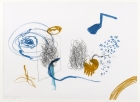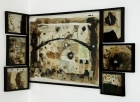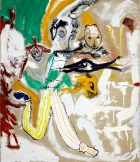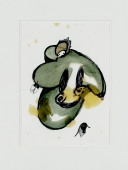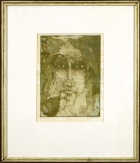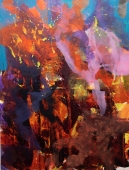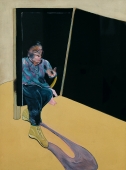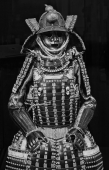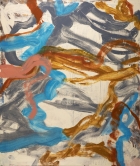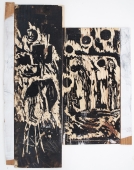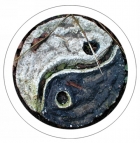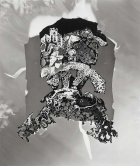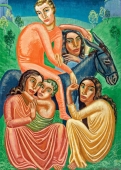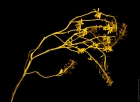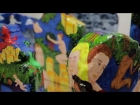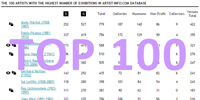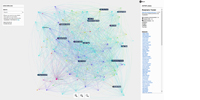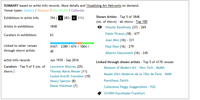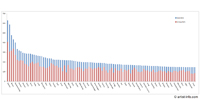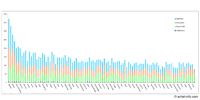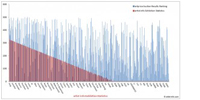
Artist | Katharina Fritsch (*1956)
https://www.artist-info.com/artist/Katharina-Fritsch
Biography
Biography
born in 1956
About the work (english / deutsch)
About the work (english / deutsch)
Tischgesellschaft
This gathering of 32 men may remind us more of a men's club than anything else. Perhaps we can see in it the dominance of men in our society. Associations of power spring to mind. As power is predominantly exercised by men, there is a certain inner link. Yet Fritsch does not seek to express power in her work and, in the end, it is only the sheer number of figures that suggests power. These men are not presented as powerful figures. Indeed, they seem almost vulnerable und helpless. They are androgynous. They are first and foremost people. Gender is irrelevant here.
Tischgesellschaft was chosen as the title of the 16 m longfrec-standing installation which can be viewedf,rom all sides. Though Tischgesellschaft actually means "dinner party ", it is, like many German words, made up of two separate nouns: "Tisch" (table) and "Gesellschaft" (society or company).
In this way, it is not only a piece of furniture that presents an object, but also a concept that combines subjects. It is an object at which subjects gather, meet, dine in company, forming a society, communicating. Daily life, an everyday occurrence, is expressed here. But there is neither communication nor community at this table; not even non-verbal communication in the form of, say, eye contact. No emotion can be discerned. Isolation, anonymity and uniformity rule. The individual becomes part of a faceless mass, embodying the loneliness of the crowd and the isolation of society. In this respect, the Tischgesellschaft may be seen as an expression of society today. The individual is insignificant, merely a functional part of society, easy to replace. It is generally up to us whether we submit to these social pressures. We are pars pro toto, part of the whole, and can thus influence the whole either positively or negatively.
German text by Ilonka Czerny / Translation by Ishbel Flett
(Extract - Full printed version available in the Museum)
MMK - Museum für Moderne Kunst, Frankfurt am Main
Tischgesellschaft
Die Anzahl von 32 Männern läßt weniger an Tischgesellschaft als an Männergesellschaft denken. Darin könnte aber auch die Dominanz des Mannes in der heutigen Gesellschaft gesehen werden. Assoziationen der Machtausübung drängen sich auf. Da Macht vorwiegend von Männern ausgeübt wird, besteht darin der gewisse innere Zusammenhang. Doch Macht möchte Fritsch in ihren Arbeiten primär nicht zum Ausdruck bringen, und letztlich läßt in dieser Arbeit nur die große Anzahl der Figuren an Macht denken. Denn diese Männer stellen sich nicht als mächtig dar, sie wirken eher hilf- und wehrlos. Sie wirken androgyn. In erster Linie sind sie als Menschen abgebildet, ihr Geschlecht ist letztlich nicht relevant.
Tischgesellschaft wurde als Titel dieser 16 m langen umgehbaren Installation gewählt, zusammengesetzt aus den zwei Substantiven "Tisch" und "Gesellschaft". Ein Möbelstück, das ein Objekt darstellt und ein Begriff, der Subjekte vereinigt. Ein Objekt, an dem Subjekte zusammenkommen, sich treffen, an dem gespeist und Gemeinschaft gebildet wird und Kommunikation stattfinden kann. Der Alltag, das Tägliche, das All-tägliche findet hier seinen Ausdruck. An diesem Tisch aber findet weder Kommunikation noch Gemeinschaft statt. Selbst eine non-verbale Kommunikation, z. B. durch Blickkontakt, geht nicht von den Protagonisten aus. Weder Regung noch Emotionen werden hier deutlich. Es herrscht Isolation, Anonymität und Uniformität. Der Mensch wird zur gesichtslosen Masse. Er verkörpert Einsamkeit in der Masse und vereinsamt in der Gesellschaft.
Die Tischgesellschaft kann somit Ausdruck unserer heutigen Gesellschaft sein, in der Egoismus und Leistungsdenken vorherrschen. Der Mensch als Individuum erlangt kaum Bedeutung, er wird nur als Funktion der Gesellschaft genutzt, er wird dadurch austauschbar. Meistens liegt es an uns selbst, ob wir uns diesen gesellschaftlichen Zwängen unterwerfen. Wir sind pars pro toto Teil des Ganzen und können es somit beeinflussen - positiv oder negativ.
Text von Ilonka Czerny
(Auszug - Der vollständige Text ist als Informationsblatt beim Museum erhältlich)
MMK - Museum für Moderne Kunst, Frankfurt am Main
 offers / Requests offers / Requests  |
About this service |
|---|
 Exhibition Announcements
Exhibition Announcements
 Visualization |
Learn more about this service | ||
|---|---|---|---|
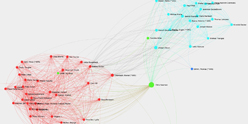
Interested in discovering more of this artist's networks?
3 easy steps: Register, buy a package for a visualization, select the artist.
See examples how visualization looks like for an artist, a curator, or an exhibition place: Gallery, museum, non-profit place, or collector.

Exhibition History

|
SUMMARY based on artist-info records. More details and Visualizing Art Networks on demand. Venue types: Gallery / Museum / Non-Profit / Collector |
||||||||||||
| Exhibitions in artist-info | 102 (S 27/ G 75) |
Did show together with - Top 5 of 1161 artists (no. of shows) - all shows - Top 100
|
||||||||||
| Exhibitions by type | 102: 25 / 40 / 35 / 2 | |||||||||||
| Venues by type | 77: 17 / 27 / 31 / 2 | |||||||||||
| Curators | 46 | |||||||||||
| artist-info records | Jan 1984 - Mar 2024 | |||||||||||
|
Countries - Top 5 of 11 Germany (44) United States (23) Belgium (6) Switzerland (5) France (4) |
Cities - Top 5 of 42 New York (16) Frankfurt am Main (9) Düsseldorf (7) London (6) Krefeld (4) |
Venues (no. of shows )
Top 5 of 77
|
||||||||||
Curators (no. of shows)
Top 5 of 46
|
| Nicole Klagsbrun | G | Nov 2023 - Mar 2024 | New York | (234) | +0 | |
| Museum Folkwang | S | May 2016 - Oct 2016 | Essen | (417) | +1 | |
| Fondazione Nicola Trussardi | G | Aug 2015 - Nov 2015 | Milano | (21) | +0 | |
| Gioni, Massimiliano (Curator) | +0 | |||||
| Staatsgalerie Stuttgart | G | May 2015 - Sep 2015 | Stuttgart | (68) | +0 | |
| Deutsche Bank Collection - Artists | S | Apr 2015 - Apr 2015 | Frankfurt am Main | (1) | +0 | |
| Tower - MMK | G | Oct 2014 - Jun 2015 | Frankfurt am Main | (10) | +0 | |
| Gaensheimer, Susanne (Curator) | +0 | |||||
| Gorschlüter, Peter (Curator) | +0 | |||||
| Keep reading |

















